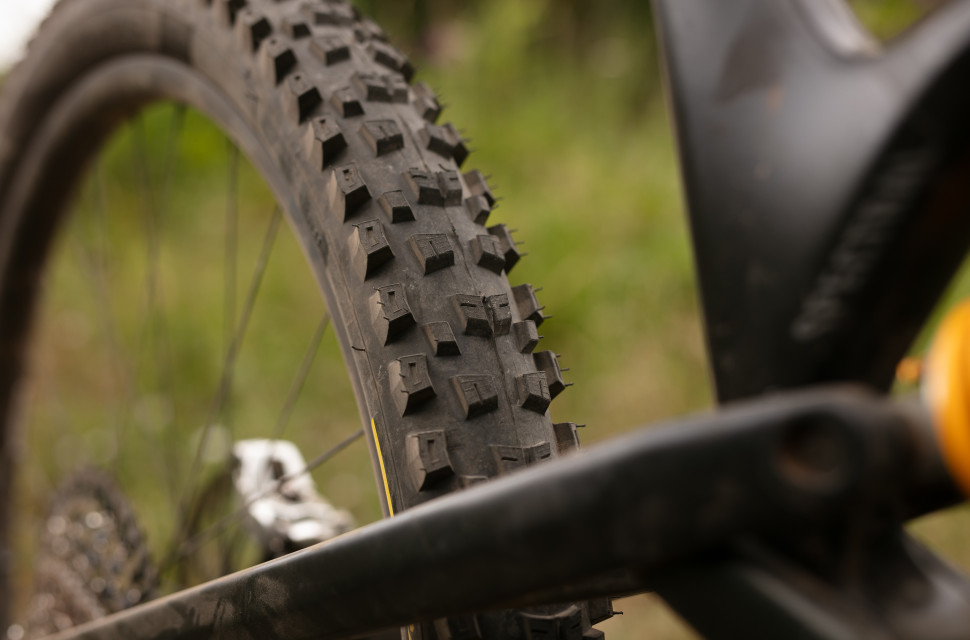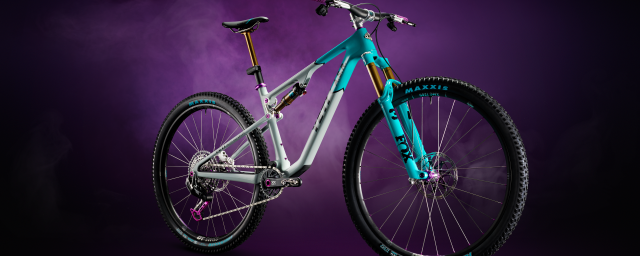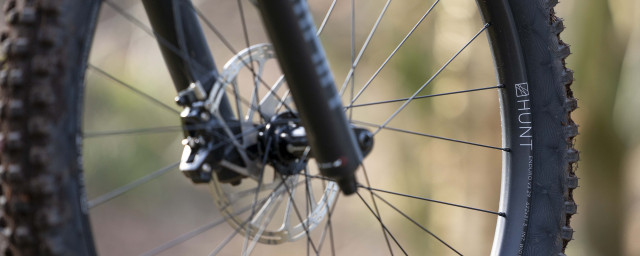Mountain bike tyres - Everything you need to know about off-road rubber

Mountain bike tyres are the only contact points between the trail and your bike and are vital when it comes to maintaining grip on the terrain. With an absolute sea of options on the market, buying fresh rubber for your bike can be a confusing endeavour. Furthermore, picking the wrong tyre for your riding style can ruin the experience and leave you out of pocket. In this feature, we’re going to break down each aspect of a mountain bike tyre and explain how it’ll positively or negatively affect how your bike's handling credentials.
- Tubeless mountain bike tyres - everything you need to know
- Mountain bike tyre pressures – everything you need to know
- Best mountain bike tyres - quality rubber for trail, XC and enduro
To start, let’s dive into how a mountain bike tyre is constructed, as the process involved is a little more than just a black rubber band. Starting off with the carcass (or casing) – this is the foundation of a tyre and each layer builds on this, such as the bead, which helps form an airtight seal by hooking into the rim.
When people talk about the tread, they’re talking about the pattern or knobs on the tyre and the profile. And finally, the sidewall is the side of the tyre, where brands like to add puncture-protective measures.
1. Carcass (casing)
A tyre’s carcass is made up of a bunch of rubber-coated threads measured in tpi or threads per inch which denotes the number of threads within a square inch. Most of the time, tyres either come with a 60 or 120tpi carcass. The former is created using thicker and therefore stiffer threads that take up more space in the casing. A 60tpi casing will also be heavier. A 120tpi casing uses a greater number of thinner threads resulting in a lighter, more supple carcass that’ll be more prone to puncture.
These casings can be found in single- and dual-ply options with dual-ply carcasses offering more stiffness, better support and increased puncture resistance at the expense of extra weight and more resistance to rolling. A single-ply casing will be freer to conform to the terrain, allowing for an easier time while pedalling and resulting in a lighter weight. As the tyre is able to bend around bumps, it’ll also offer more grip.
To put those casings into the context of riding, tyres with a single-ply high tpi rating will be favoured by cross-country mountain biking athletes for the lightweight and lower rolling resistance but this comes at the expense of puncture protection. Single-ply higher tpi tyres will be found on XC tyres with low-profile tread patterns to best suit that style of riding.
Single-ply lower tpi tyres edge more into trail and enduro riding as they offer better puncture protection with the sacrifice of low weight. With these kinds of tyres, brands often add special inserts or layers to add a bit of support and puncture protection to the tyre’s sidewall to help performance in the corners without adding the weight of a dual-ply construction.
Dual-ply higher tpi tyres lend themselves best to aggressive enduro mountain biking as they strike a delicate balance between low weight and puncture protection while adding much-needed support to the tyre in corners.
Finally, dual-ply lower tpi tyres are reserved for those who want all of the protection and aren’t too fussed about the weight – this is found in the world of downhill mountain biking. At these speeds, tyre support is crucial in order to keep it in place when hitting corners hard. Of course, that puncture protection is also imperative as these guys are riding incredibly rough tracks, very, very quickly.
When looking at a tyre casing, Maxxis for example, refers to its casing range spans EXO (the lightest but coming with sidewall inserts) and EXO+ which offers more protection by combining a protective carcass layer and puncture-resistant sidewall inserts. There's also Double Down which uses a dual-ply 120tpi casing with a heavy-duty butyl insert at the sidewall.
2. Tread patterns
Mountain bike tyres come in a huge selection of tread patterns, all of which excel in certain areas and struggle in others. As with many things in the world of mountain biking, your tread pattern selection is one of balance. A tyre’s tread pattern is often referred to as low profile, meaning that its knobs are short or aggressive, the latter indicating that its knobs are tall. There are also semi-slick tyres that blend the two attributes.
Low-profile treads are mostly chosen by cross-country racers, bike packers or those who want to cover miles quickly. That’s because they offer lower rolling resistance, which makes it easier to pedal faster. While they should offer excellent grip over hard terrain, low-profile tyres sacrifice grip elsewhere as the tread isn’t tall enough to dig into the ground.
Tyres with small treads also offer less braking power because the knobs just aren’t very tall. Excellent examples of a low profile tread are Schwalbe’s Racing Ray and Racing Ralph tyres. They’re very round tyres and their knobs aren’t very tall.
Semi-slick tyres blend the shoulder knobs (knobs at the very edges of the tyre) of a more aggressively treaded tyre with a low profile centre tread. The idea behind these is to offer the pedalling efficiency that’s typical of a tyre with little knobs with the out-right cornering grip of a tyre with bigger knobs. If we take the Maxxis Minion SS, for example, the difference between the centre and the shoulders is significant.
More aggressive appeals to trail, enduro and downhill riders where the lowest possible rolling resistance isn’t quite as important as grip – and this is where the choice in rubber compound and casing really come into play. A taller tread will dig into soft terrain much more effectively, resulting in better grip in these areas, as well as solid power under braking. Good aggressive trail, enduro and downhill tyres come in the form of the WTB Verdict, Maxxis Minion DHF or Maxxis Assegai.
If we push things a little further, we start going into the mud-tyre territory. These thread patterns are widely spaced to help clear clogged-up mud and they’re super tall in order to dig into loose trails. Usually, these are favoured by downhill racers who don’t have the choice of calling it quits if it’s a little too wet outside.
For softer terrain through the winter months, tyres such as the Maxxis Shorty and Schwalbe Magic Mary offer a solid mix of performance in loose, loamy trails. These tyres are also chosen by those who ride in the dust as their tall and widely spaced knobs can bite through the fine sandy layers or slop, and reach the grippy surface underneath.
This is where a careful choice of tread pattern is important as it very much depends on the terrain you regularly ride. If you ride somewhere where it doesn’t rain very much or your trails are hard, well groomed and predictable, you won’t need the most aggressive tread as the tyre could end up feeling skittish as it rolls on the very top of its tread. You’ll also be coping with greater rolling resistance.
Tyre treads can then be front and rear-specific in order to offer the best characteristics for each end of the bike.
3. Rubber compound
Every tyre’s tread is made using rubber and, like everything else, rubber compounds are not made equal, even though they can be similar from tyre to tyre. Here, durometer is used to measure the hardness with a lower number (around 40a) being softer and the higher, the harder (60a).
A rubber compound’s durometer or hardness is important for three reasons, namely rate of wear, grip and rolling resistance. A harder compound will roll faster and wear slower, however, it won’t be as grippy. Whereas a soft compound will be super grippy, but it won’t roll as fast or last as long.
As such, many choose to equip their bikes with harder rubber compounds at the rear of the bike so they can benefit from fast rolling and slower wear, as this is often where drag and rate of wear usually influence a ride. At the front riders will then pick a softer compound as a front tyre wears slower and doesn’t have as great an effect on rolling resistance. However, when it comes to enduro and downhill racing, riders will choose soft compounds for both ends of the bike as wear and rolling resistance isn’t as important as all-out grip.
When it comes to rubber compounds, brands will often use multiple durometers in a single tyre, such as Maxxis’ 3C. Here, the centre tread uses a harder rubber to reduce wear and decrease rolling resistance while the shoulder knobs are softer to provide more grip in the corners. The shoulder knobs won’t suffer as quickly from wear either, as they don’t contact the ground as frequently.
The entire tread pattern is supported by a firmer layer of rubber underneath. This is aimed to offer support to each of the knobs to stop them from rolling and squirming under heavy loads. This does drastically decrease grip as the tyre wears through its outer compounds.
4. Tyre width
Much like mountain bike geometries, tyre widths have been getting more and more extreme. Widths appear to have reached a limit and are now standardising with plus-size tyres becoming something of a rarity on modern mountain bikes. A tyre’s width has a huge role to play not only in the level of grip offered but also comfort (less air pressure).
There's also an argument about the correlation between a tyre's width and it's rolling resistance. A wider tyre has a larger contact patch with the ground, which means more friction than a narrow tyre. However, as a wider tyre can contain a larger air volume and accommodate lower pressures, it also provides less rolling resistance.
Another benefit to the larger air volume is the comfort that a wide tyre will offer. There's simply more give and less risk of pinch flats. Fatter tyres, however, do add grams to your bike because of the increase in material required.
The width of a tyre does have specific benefits in specific situations. For example, fat bikes offer unparalleled grip over sand, snow and soft surfaces where traditional tyres will cut through to the point where rolling resistance is too high. However, on the terrain where regular mountain bikes thrive, the 2.8in to three-inch tyres may feel vague, squirm or move on the rim and roll slowly. Tyres less than 2.8in are better supported on mountain bike-width rims, roll faster on the usual terrains and feel more precise on the trail.
5. How to choose the best tyre for you
It’s a balancing act to find the best tyre for your bike but before spending the cash, think about the terrain that you most regularly ride in. If your trails are technical, brake heavy and loose or wet, an aggressive tread with a soft compound is a wise choice. If there are a lot of puncture-inducing rock gardens, then it makes sense to pick a tyre with a stronger and more protective carcass.
Though if you stick to easier-going trail centres, prefer munching miles or want to go as fast as possible without constant assistance from gravity, then a lighter-cased, lower-profile tread with a harder rubber compound will work just fine.
While it’s easy to get carried away, the most aggressive tread patterns sometimes aren’t the grippiest and the most protective carcasses may actually not be of much benefit. Riding over hard surfaces with a tyre that has a tall tread pattern doesn’t offer as much grip as a low-profile tyre because the tyre’s contact patch and surface area is reduced. This leads to the tyres feeling skittish and unconfident. Then if your riding doesn’t include massively fast, or technical trails you’ll only be lugging around extra weight when choosing a tyre with a strong carcass.
It’s a case of trial and error, especially when it comes to tyre casings. If you’re puncturing regularly then choosing a stronger casing would be the way to go. We've got a comprehensive range of tyre reviews to assist with your search.
















